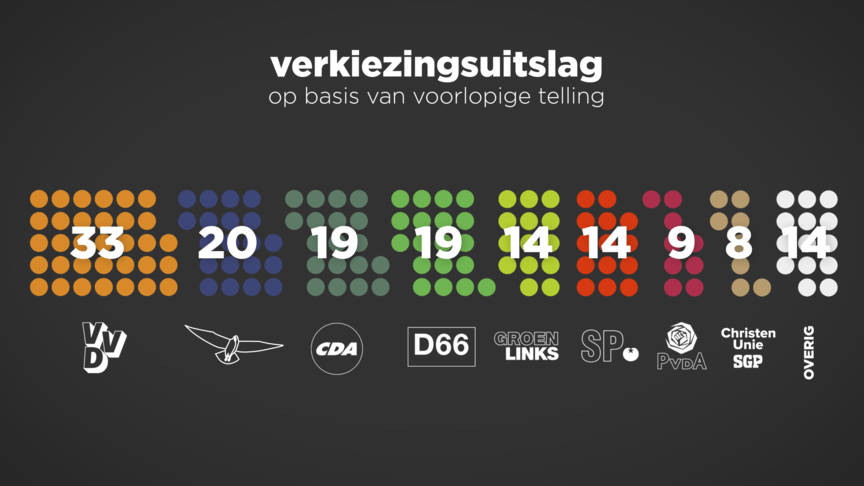The day after the parliamentary elections in the Netherlands the global press is still firmly focused on PVV candidate Geert Wilders. His far right party had a solid evening but failed to beat incumbent VVD or receive enough seats to make a coalition without him impossible, meaning that he will likely remain in the opposition despite being the second largest party in the Netherlands. (For more on why this is, see our Dutch Election explainer or our previous analysis of Wilders’ coalition conundrum). Many are hailing this as a defeat for populism and a victory for Europe/ centrists /the progressive left. But of course, we are interested in digging into what the implications of the results are for immigration and asylum policy in the Netherlands.
Pro-Refugee parties won big…
The parties with the most liberal views on refugees made significant gains. GroenLinks, whose campaign focused on diversity and opposition to racism and xenophobia, while endorsing rights for refugees and rejected asylum seekers, more than tripled the number of seats they gained in comparison to 2012, going from 4 t0 14 seats, while D66, perhaps the second most pro-refugee party (at least on paper) gained 10 seats to tie for third biggest party. Meanwhile, brand new party DENK gained 3 seats, with a message of tolerance for people with migration background to the Netherlands, backing such positions as diversity quotas for government positions and the introduction of policies that de-stigmatize foreigners and counter racism.
In one of the biggest shockers of the evening, workers party PvdA lost a staggering 29 seats. That they did so poorly while other liberal parties made gains is interesting, but from our perspective its worth noting that this was the only party who was Left on social issues but took a somewhat harsher tone on refugees and especially economic migrants, and they were decimated.
…But Anti-Refugee parties won big too
Geert Wilders’ PPV, who took by far the harshest stance of any of the parties against all forms of refugees, immigrants and foreigners, gained 5 seats, becoming the second largest party in the Tweede Kamer. Less hyped but equally important, the CDA surged to tie for third place, picking up 7 seats. The CDA‘s position is similar to the VVD (who remains biggest party despite losing 10 seats) that refugees should stay in their own region, and those who do come to the Netherlands should only receive support to the extent that they can be well set up to return. Additionally, they support tightening up rules on family reunification. SGP and CU both did solidly with a similarly strict stance on refugees (while making provisions for especially vulnerable groups, such as children.)
Meanwhile, the far-right Forum voor Demokratie (FVD) made it into the parliament for the first time, gaining two seats running on a platform that centered on direct democracy, restricting immigration and leaving the EU. Party leader Thierry Baudet presents himself as a younger and more intellectual Wilders-type, with connections to the US alt-right scene.
The resulting government seems unlikely to make big shifts in asylum policy
It always takes some time to form a government in the Netherlands, and given that all major parties have vowed to exclude PPV, the second most popular party, any likely coalition will probably be a combination of VVD, CDA, D66 and one or more others. Rutte will likely remain PM, and parties that are basically opposed to the Netherlands accepting more refugees in one way or another will hold at least 72 out of 150 seats in parliament and will dominate the ruling coalition. Its thus safe to say we can expect more of the same: subsistence level support for asylum seekers, lots of rejections, and suport for development cooperation in regional sending zones.
Depending on whether Groenlinks or SP also join the ruling coalition they may seek to liberalize immigration policy, but will face an uphill battle.
Questions going forward:
–Is high voter turnout far-right kryptonite? As the evening unfolded the media was surprised by the extremely high voter turnout – 82% overall. High turnout doesn’t necessarily benefit the left or the right, but as state broadcaster NOS reported, younger people favored more liberal parties, and high voter turnout usually means increased youth participation.
–Does flirting with the far-right work equally well for the center right and the left? As many have pointed out, the VVD and CDA both took a page (or at least a line) out of Wilders’ book in the way they talked about refugees and immigrants, most notably when Rutte said immigrants should act normal or “piss off” in a tv interview. Talking tough on refugees and immigrants, but not using what Rutte called “the wrong kind of populism” managed to keep these parties in the lead. Not so for PvdA, who campaigned on protecting Dutch identity and patriotic values while backing restrictive measures for refugees and asylum like VVD and CDA, but lost terribly for it. Left/liberal parties who didn’t emulate this type of rhetoric, however, did well, especially among young people.
–What does this mean for the French election? That may be the most important question, but the answer is far from apparent.


One thought on “Dutch Election Results: Mixed Signals on Migration”